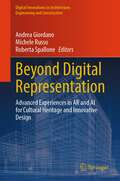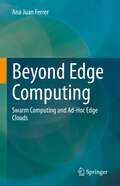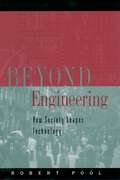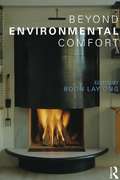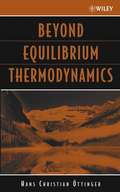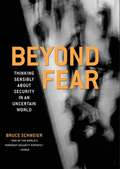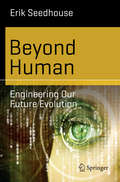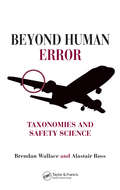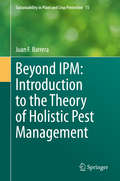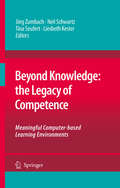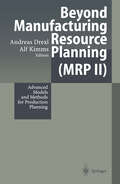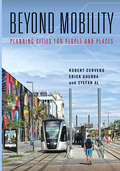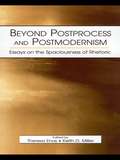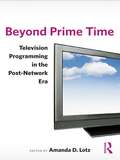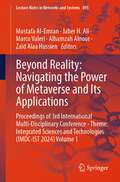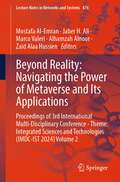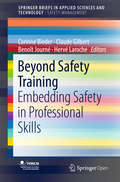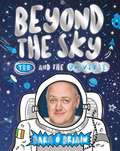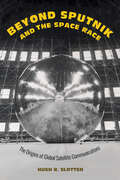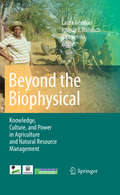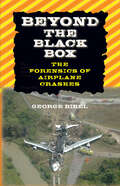- Table View
- List View
Beyond Digital Representation: Advanced Experiences in AR and AI for Cultural Heritage and Innovative Design (Digital Innovations in Architecture, Engineering and Construction)
by Andrea Giordano Michele Russo Roberta SpalloneThis book collects contributions which showcase the impact of new augmented reality (AR) and artificial intelligence (AI) technologies considered jointly in the fields of cultural heritage and innovative design. AR is an alternative path of analysis and communication if applied to several fields of research, in particular if related to space and artifacts in it. This happens because the neural network development strengthens the relationship between augmented reality and artificial intelligence, creating processes close to human thought in shorter times. In the last years, the AR/AI expansion and the future scenarios have raised a deep trans-disciplinary speculation. The disciplines of representation (drawing, surveying, visual communication), as a convergence place of multidisciplinary theoretical and applicative studies related to architecture, city, environment, tangible and intangible cultural heritage, are called to contribute to the international debate. The book chapters deal with augmented reality and artificial intelligence, analyzing their connections as research tools for knowing the environment. In particular, the topics focus on the intersection between real and virtual world and on the heuristic role of drawing in the enhancement and management of cultural heritage, in planning and monitoring the architecture, the environment, or the infrastructures. Scientists involved in AR and AI research applied separately or together in the field of cultural heritage, architectural design, urban planning, and infrastructures analysis, as well as members of public and private organizations make up interdisciplinary groups that fuel the discussion focusing on the priorities and aims of the research related to the disciplines of representation.
Beyond Edge Computing: Swarm Computing and Ad-Hoc Edge Clouds
by Ana Juan FerrerThis book explores the most recent Edge and Distributed Cloud computing research and industrial advances, settling the basis for Advanced Swarm Computing developments. It features the Swarm computing concepts and realizes it as an Ad-hoc Edge Cloud architecture.Unlike current techniques in Edge and Cloud computing that solely view IoT connected devices as sources of data, Swarm computing aims at using the compute capabilities of IoT connected devices in coordination with current Edge and Cloud computing innovations. In addition to being more widely available, IoT-connected devices are also quickly becoming more sophisticated in terms of their ability to carry considerable compute and storage resources. Swarm computing and Ad-hoc Edge Cloud take full advantage of this trend to create on-demand, autonomic and decentralized self-managed computing infrastructures.Focusing on cognitive resource and service management, the book examines the specific research challenges of the Swarm computing approach, related to the characteristics of IoT connected devices that form the infrastructure. It also offers academics and practitioners insights for future research in the fields of Edge and Swarm computing.
Beyond Engineering: How Society Shapes Technology (Sloan Technology)
by Robert PoolWe have long recognized technology as a driving force behind much historical and cultural change. The invention of the printing press initiated the Reformation. The development of the compass ushered in the Age of Exploration and the discovery of the New World. The cotton gin created the conditions that led to the Civil War. Now, in Beyond Engineering, science writer Robert Pool turns the question around to examine how society shapes technology. Drawing on such disparate fields as history, economics, risk analysis, management science, sociology, and psychology, Pool illuminates the complex, often fascinating interplay between machines and society, in a book that will revolutionize how we think about technology. We tend to think that reason guides technological development, that engineering expertise alone determines the final form an invention takes. But if you look closely enough at the history of any invention, says Pool, you will find that factors unrelated to engineering seem to have an almost equal impact. In his wide-ranging volume, he traces developments in nuclear energy, automobiles, light bulbs, commercial electricity, and personal computers, to reveal that the ultimate shape of a technology often has as much to do with outside and unforeseen forces. For instance, Pool explores the reasons why steam-powered cars lost out to internal combustion engines. He shows that the Stanley Steamer was in many ways superior to the Model T--it set a land speed record in 1906 of more than 127 miles per hour, it had no transmission (and no transmission headaches), and it was simpler (one Stanley engine had only twenty-two moving parts) and quieter than a gas engine--but the steamers were killed off by factors that had little or nothing to do with their engineering merits, including the Stanley twins' lack of business acumen and an outbreak of hoof-and-mouth disease. Pool illuminates other aspects of technology as well. He traces how seemingly minor decisions made early along the path of development can have profound consequences further down the road, and perhaps most important, he argues that with the increasing complexity of our technological advances--from nuclear reactors to genetic engineering--the number of things that can go wrong multiplies, making it increasingly difficult to engineer risk out of the equation. Citing such catastrophes as Bhopal, Three Mile Island, the Exxon Valdez, the Challenger, and Chernobyl, he argues that is it time to rethink our approach to technology. The days are gone when machines were solely a product of larger-than-life inventors and hard-working engineers. Increasingly, technology will be a joint effort, with its design shaped not only by engineers and executives but also psychologists, political scientists, management theorists, risk specialists, regulators and courts, and the general public. Whether discussing bovine growth hormone, molten-salt reactors, or baboon-to-human transplants, Beyond Engineering is an engaging look at modern technology and an illuminating account of how technology and the modern world shape each other.
Beyond Environmental Comfort
by Boon Lay OngBeyond Environmental Comfort highlights some of the key ideas that form the foundation of the field of environmental comfort and, at the same time, gives voice to some of the concerns and considerations on the limitations of the field as it stands today. Bringing together a range of foremost thinkers in their respective fields - Michel Cabanac, Derek Clements-Croome, Nick Baker, Harold Marshall, Juhani Pallasmaa, Dean Hawkes, and Constance Classen - this book argues for a deeper appreciation of how environmental comfort may be understood in terms of our relationship with the environment rather than as independent qualities. For the first time these diverse views are brought together by Editor Boon Lay Ong to present insights into a world beyond what is normally covered in academic research. In the process, an attempt is made to define the field for the future. This book shows that it is by understanding just how environmental design needs to go beyond mere comfort and deal with well-being that we can meaningfully design our future.
Beyond Environmental Comfort
by Boon Lay OngBeyond Environmental Comfort highlights some of the key ideas that form the foundation of the field of environmental comfort and, at the same time, gives voice to some of the concerns and considerations on the limitations of the field as it stands today. Bringing together a range of foremost thinkers in their respective fields - Michel Cabanac, Derek Clements-Croome, Nick Baker, Harold Marshall, Juhani Pallasmaa, Dean Hawkes, and Constance Classen - this book argues for a deeper appreciation of how environmental comfort may be understood in terms of our relationship with the environment rather than as independent qualities. For the first time these diverse views are brought together by Editor Boon Lay Ong to present insights into a world beyond what is normally covered in academic research. In the process, an attempt is made to define the field for the future. This book shows that it is by understanding just how environmental design needs to go beyond mere comfort and deal with well-being that we can meaningfully design our future.
Beyond Equilibrium Thermodynamics
by Hans Christian ÖttingerBeyond Equilibrium Thermodynamics fills a niche in the market by providing a comprehensive introduction to a new, emerging topic in the field. The importance of non-equilibrium thermodynamics is addressed in order to fully understand how a system works, whether it is in a biological system like the brain or a system that develops plastic. In order to fully grasp the subject, the book clearly explains the physical concepts and mathematics involved, as well as presenting problems and solutions; over 200 exercises and answers are included. Engineers, scientists, and applied mathematicians can all use the book to address their problems in modelling, calculating, and understanding dynamic responses of materials.
Beyond Fear: Thinking Sensibly About Security in an Uncertain World
by Bruce SchneierMany of us, especially since 9/11, have become personally concerned about issues of security, and this is no surprise. Security is near the top of government and corporate agendas around the globe. Security-related stories appear on the front page everyday. How well though, do any of us truly understand what achieving real security involves?In Beyond Fear, Bruce Schneier invites us to take a critical look at not just the threats to our security, but the ways in which we're encouraged to think about security by law enforcement agencies, businesses of all shapes and sizes, and our national governments and militaries. Schneier believes we all can and should be better security consumers, and that the trade-offs we make in the name of security - in terms of cash outlays, taxes, inconvenience, and diminished freedoms - should be part of an ongoing negotiation in our personal, professional, and civic lives, and the subject of an open and informed national discussion.With a well-deserved reputation for original and sometimes iconoclastic thought, Schneier has a lot to say that is provocative, counter-intuitive, and just plain good sense. He explains in detail, for example, why we need to design security systems that don't just work well, but fail well, and why secrecy on the part of government often undermines security. He also believes, for instance, that national ID cards are an exceptionally bad idea: technically unsound, and even destructive of security. And, contrary to a lot of current nay-sayers, he thinks online shopping is fundamentally safe, and that many of the new airline security measure (though by no means all) are actually quite effective. A skeptic of much that's promised by highly touted technologies like biometrics, Schneier is also a refreshingly positive, problem-solving force in the often self-dramatizing and fear-mongering world of security pundits.Schneier helps the reader to understand the issues at stake, and how to best come to one's own conclusions, including the vast infrastructure we already have in place, and the vaster systems--some useful, others useless or worse--that we're being asked to submit to and pay for.Bruce Schneier is the author of seven books, including Applied Cryptography (which Wired called "the one book the National Security Agency wanted never to be published") and Secrets and Lies (described in Fortune as "startlingly lively...¦[a] jewel box of little surprises you can actually use."). He is also Founder and Chief Technology Officer of Counterpane Internet Security, Inc., and publishes Crypto-Gram, one of the most widely read newsletters in the field of online security.
Beyond Human: Engineering Our Future Evolution (Science and Fiction)
by Erik SeedhouseBeyond Human is an informative and accessible guide for all those interested in the developing sciences of genetic engineering, bio printing and human cloning. Illustrating the ideas with reference to well-known science fiction films and novels, the author provides a unique insight into and understanding of how genetic manipulation, cloning, and other novel bio-technologies will one day allow us to redesign our species. It also addresses the legitimate concerns about “playing God”, while at the same time embracing the positive aspects of the scientific trajectory that will lead to our transhuman future.
Beyond Human Error: Taxonomies and Safety Science
by Brendan Wallace Alastair RossA ground-breaking new book, Beyond Human Error: Taxonomies and Safety Science deconstructs the conventional concept ofhuman error and provides a whole new way of looking at accidents and how they might be prevented. Based on research carried out in the rail, nuclear, and defense industries, the authors show how, by concentrating solely on
Beyond IPM: Introduction to the Theory of Holistic Pest Management (Sustainability in Plant and Crop Protection #15)
by Juan F. BarreraAbout 15 years ago, we asked ourselves why the methods developed by the research institutions for the management of pests were almost not used by small landholder farmers. It seemed obvious to us that conventional pest control –called “Integrated Pest Management”– was based on a reductionist approach. In reviewing the literature on the subject, we found that our concern was not new or unique. The agreement of some authors with our ideas reinforced our efforts to find a holistic approach to pest management. We took two central ideas to develop the holistic approach: First, pest management actions must put the farmer at the center of the system. Second, pest management must consider not only both pests but the other important components of the system in question. This approach based on the farmers and the systems in which they are immersed, is called “Holistic Pest Management” or HPM. In this book, I present the philosophy and practice of HPM, a new paradigm of pest management.
Beyond Knowledge: Meaningful Computer-based Learning Environments
by Jörg Zumbach Liesbeth Kester Neil Schwartz Tina SeufertThe edited and peer reviewed volume presents selected papers of the conference “Beyond knowlegde: the legacy of competence” organized by EARLI SIG Learning and Instruction with Computers in cooperation with SIG Instructional Design. It reflects the current state-of-the-art work of scholars worldwide within the area of learning and instruction with computers. Mainly, areas of computer-based learning environments supporting competence-focused knowledge acquisition but also foundational scientific work are addressed. More specific, contents cover cognitive processes in hypermedia and multimedia learning, social issues in computer-supported collaborative learning, motivation and emotion in Blended Learning and e-Learning.
Beyond Manufacturing Resource Planning (MRP II): Advanced Models and Methods for Production Planning
by Andreas Drexl Alf KimmsThe logic of Manufacturing Resource Planning (MRP II) is im plemented in most commercial production planning software tools and is commonly accepted by practitioners. However, these peo ple are not satisfied with production planning and complain about long lead times, high work-in-process, and backlogging. As many researchers have pointed out, the reason for these shortcomings is inherent to the methods that are used. The research community is thus eager to find more sophisticated approaches. This book is an attempt to compile some state-of-the-art work in the field of production planning research. It includes mate rial that somehow dominates the existing MRP II concept. 15 ar ticles written by 36 authors from 10 countries cover many aspects related to MRP II. All papers went through a single-blind refere eing process before they were selected for being published in this book. When we received papers for this issue, we discovered that MRP II is a topic about which not only management scientists show interest. As the list of authors proves, industrial engineers, computer scientists, and-operations researchers from academia as well as practitioners have contributed to this book. This, we hope, makes the book of value for a broad audience. We thank all authors who submitted papers. And, we are in debted to Dr. Werner Muller from Springer for his support in this book project.
Beyond Mobility: Planning Cities for People and Places
by Robert Cervero Erick Guerra Stefan AlThis volume is about prioritizing the needs and aspirations of people and the creation of great places. This is as important, if not more important, than expediting movement. A stronger focus on accessibility and place creates better communities, environments, and economies. Rethinking how projects are planned and designed in cities and suburbs needs to occur at multiple geographic scales, from micro-designs (such as parklets), corridors (such as road-diets), and city-regions (such as an urban growth boundary). It can involve both software (a shift in policy) and hardware (a physical transformation). Moving beyond mobility must also be socially inclusive, a significant challenge in light of the price increases that typically result from creating higher quality urban spaces.
Beyond Postprocess and Postmodernism: Essays on the Spaciousness of Rhetoric
by Theresa Enos Keith D. MillerIn this collection of original essays, editors Theresa Enos and Keith D. Miller join their contributors--a veritable "who's who" in composition scholarship--in seeking to illuminate and complicate many of the tensions present in the field of rhetoric and composition. The contributions included here emphasize key issues in past and present work, setting the stage for future thought and study. The book also honors the late Jim Corder, a major figure in the development of the rhetoric and composition discipline. In the spirit of Corder's unfinished work, the contributors to this volume absorb, probe, stretch, redefine, and interrogate classical, modern, and postmodern rhetorics--and challenge their limitations. Beyond Postprocess and Postmodernism: Essays on the Spaciousness of Rhetoric will be of interest to scholars, teachers, and students in rhetoric and composition, English, and communication studies. Offering a provocative discussion of postprocess composition theories and pedagogies and postmodern rhetorics, as well as the first thorough consideration of Jim Corder's contributions, this work is certain to influence the course of future study and research.
Beyond Postprocess and Postmodernism: Essays on the Spaciousness of Rhetoric
by Theresa Jarnagi Enos Keith D. Miller Jill McCrackenIn this collection of original essays, editors Theresa Enos and Keith D. Miller join their contributors--a veritable "who's who" in composition scholarship--in seeking to illuminate and complicate many of the tensions present in the field of rhetoric and composition. The contributions included here emphasize key issues in past and present work, setting the stage for future thought and study. The book also honors the late Jim Corder, a major figure in the development of the rhetoric and composition discipline. In the spirit of Corder's unfinished work, the contributors to this volume absorb, probe, stretch, redefine, and interrogate classical, modern, and postmodern rhetorics--and challenge their limitations. Beyond Postprocess and Postmodernism: Essays on the Spaciousness of Rhetoric will be of interest to scholars, teachers, and students in rhetoric and composition, English, and communication studies. Offering a provocative discussion of postprocess composition theories and pedagogies and postmodern rhetorics, as well as the first thorough consideration of Jim Corder's contributions, this work is certain to influence the course of future study and research.
Beyond Prime Time: Television Programming in the Post-Network Era
by Amanda LotzDaytime soap operas. Evening news. Late-night talk shows. Television has long been defined by its daily schedule, and the viewing habits that develop around it. Technologies like DVRs, iPods, and online video have freed audiences from rigid time constraints—we no longer have to wait for a program to be "on" to watch it—but scheduling still plays a major role in the production of television. Prime-time series programming between 8:00 and 11:00 p.m. has dominated most critical discussion about television since its beginnings, but Beyond Prime Time brings together leading television scholars to explore how shifts in television’s industrial practices and new media convergence have affected the other 80% of the viewing day. The contributors explore a broad range of non-prime-time forms including talk shows, soap operas, news, syndication, and children’s programs, non-series forms such as sports and made-for-television movies, as well as entities such as local affiliate stations and public television. Importantly, all of these forms rely on norms of production, financing, and viewer habits that distinguish them from the practices common among prime-time series and often from each other. Each of the chapters examines how the production practices and textual strategies of a particular programming form have shifted in response to sweeping industry changes, together telling the story of a medium in transition at the beginning of the twenty-first century. Contributors: Sarah Banet-Weiser, Victoria E. Johnson, Jeffrey P. Jones, Derek Kompare, Elana Levine, Amanda D. Lotz, Jonathan Nichols-Pethick, Laurie Ouellette, Erin Copple Smith
Beyond Prime Time: Television Programming in the Post-Network Era
by Amanda LotzDaytime soap operas. Evening news. Late-night talk shows. Television has long been defined by its daily schedule, and the viewing habits that develop around it. Technologies like DVRs, iPods, and online video have freed audiences from rigid time constraints—we no longer have to wait for a program to be "on" to watch it—but scheduling still plays a major role in the production of television. Prime-time series programming between 8:00 and 11:00 p.m. has dominated most critical discussion about television since its beginnings, but Beyond Prime Time brings together leading television scholars to explore how shifts in television’s industrial practices and new media convergence have affected the other 80% of the viewing day. The contributors explore a broad range of non-prime-time forms including talk shows, soap operas, news, syndication, and children’s programs, non-series forms such as sports and made-for-television movies, as well as entities such as local affiliate stations and public television. Importantly, all of these forms rely on norms of production, financing, and viewer habits that distinguish them from the practices common among prime-time series and often from each other. Each of the chapters examines how the production practices and textual strategies of a particular programming form have shifted in response to sweeping industry changes, together telling the story of a medium in transition at the beginning of the twenty-first century. Contributors: Sarah Banet-Weiser, Victoria E. Johnson, Jeffrey P. Jones, Derek Kompare, Elana Levine, Amanda D. Lotz, Jonathan Nichols-Pethick, Laurie Ouellette, Erin Copple Smith
Beyond Reality: Proceedings of 3rd International Multi-Disciplinary Conference - Theme: Integrated Sciences and Technologies (IMDC-IST 2024) Volume 1 (Lecture Notes in Networks and Systems #895)
by Mostafa Al-Emran Jaber H. Ali Marco Valeri Alhamzah Alnoor Zaid Alaa HussienThis book addresses recent research trends concerning the role of the Metaverse in advancing the education and finance sectors from various perspectives. These trends are explored through multiple case studies employing diverse analytical approaches. The chapters aim to aid scholars and postgraduate students in pursuing future research in this domain and identifying potential developments in Metaverse applications.
Beyond Reality: Proceedings of 3rd International Multi-Disciplinary Conference - Theme: Integrated Sciences and Technologies (IMDC-IST 2024) Volume 2 (Lecture Notes in Networks and Systems #876)
by Mostafa Al-Emran Jaber H. Ali Marco Valeri Alhamzah Alnoor Zaid Alaa HussienThis book explores current research trends in the context of the Metaverse’s impact on the tourism and marketing industries while delving into some case studies on education and finance. These trends are examined through various case studies utilizing distinct analytical methods. The chapters are expected to support scholars and postgraduate students in furthering their research in this field and in recognizing prospective advancements in the applications of the Metaverse.
Beyond Safety Training: Embedding Safety in Professional Skills (SpringerBriefs in Applied Sciences and Technology)
by Corinne Bieder Claude Gilbert Benoît Journé Hervé LarocheThis book is open access under a CC BY 4.0 license.This book investigates why, despite more and more resources devoted to safety training, expectations are not entirely met, particularly in the industrial sectors that have already achieved a high safety level. It not only reflects the most precious viewpoints of experts from different disciplines, different countries, with experiences in various industrial fields at the cutting edge of theories and practices in terms of safety, professionalization and their relationships. It also consolidates the positioning of the Foundation for an Industrial Safety Culture, highlighting what is currently considered at stake in terms of safety training, taking into account the system of constraints the different stakeholders are submitted to. It reports some success stories as well as elements which could explain the observed plateau in terms of outcome. It identifies some levers for evolution for at-risk industry and outlines a possible research agenda to go further with experimental solutions.
Beyond The Sky
by Dara BriainSo you want to go into space? WHY?! (No, really - it's sort of a terrible idea. We humans are perfectly designed for life on Earth. We can walk around, breathe, drink water, eat vegetables, read books, not get poisoned or crushed to death when we go outside - it's lovely right where we are.) Not convinced? GOOD! People have been dreaming about space travel for centuries - there's something amazing about the idea of leaving our planet behind and setting out to explore the Universe - there's so much we still don't know. UK and Ireland's best-loved comedian Dara O Briain takes you on a journey from the safety of your comfiest chair to the furthest reaches of space (and beyond!)
Beyond Sputnik and the Space Race: The Origins of Global Satellite Communications
by Hugh R. SlottenA fascinating account of how the United States established the first global satellite communications system to project geopolitical leadership during the Cold War.On July 20, 1969, the world watched, spellbound, as NASA astronaut Neil Armstrong stepped off the Apollo 11 lunar module to walk on the moon. NASA estimated that 20 percent of the planet's population—nearly 650 million people—watched the moon landing footage, which was made possible by the first global satellite communications system, the International Telecommunications Satellite Organization, or Intelsat. In Beyond Sputnik and the Space Race, Hugh R. Slotten analyzes the efforts of US officials, especially during the Kennedy administration, to establish this satellite communication system and open it to all countries of the world. Locked in competition with the Soviet Union for both military superiority and international prestige, President John F. Kennedy overturned the Eisenhower administration's policy of treating satellite communications as simply an extension of traditionally regulated telecommunications. Instead of allowing private communications companies to set up separate systems that would likely primarily serve major "developed" regions, the new administration decided to take the lead in establishing a single world system. Explaining how the East-West Cold War conflict became increasingly influenced by North-South tensions during this period, Slotten highlights the growing importance of non-aligned countries in Asia, Latin America, and Africa. He also underscores the importance of a political economy of "total Cold War" in which many crucial aspects of US society became tied to imperatives of national security and geopolitical prestige. Drawing on detailed archival records to examine the full range of decisionmakers involved in the Intelsat system, Beyond Sputnik and the Space Race spotlights mid- and lower-level agency staff usually ignored by historians. One of the few works to analyze the establishment of a major global infrastructure project, this book provides an outstanding analytical overview of the history of global electronic communications from the mid-nineteenth century to the present.
Beyond Sputnik and the Space Race: The Origins of Global Satellite Communications
by Hugh R. SlottenA fascinating account of how the United States established the first global satellite communications system to project geopolitical leadership during the Cold War.On July 20, 1969, the world watched, spellbound, as NASA astronaut Neil Armstrong stepped off the Apollo 11 lunar module to walk on the moon. NASA estimated that 20 percent of the planet's population—nearly 650 million people—watched the moon landing footage, which was made possible by the first global satellite communications system, the International Telecommunications Satellite Organization, or Intelsat. In Beyond Sputnik and the Space Race, Hugh R. Slotten analyzes the efforts of US officials, especially during the Kennedy administration, to establish this satellite communication system and open it to all countries of the world. Locked in competition with the Soviet Union for both military superiority and international prestige, President John F. Kennedy overturned the Eisenhower administration's policy of treating satellite communications as simply an extension of traditionally regulated telecommunications. Instead of allowing private communications companies to set up separate systems that would likely primarily serve major "developed" regions, the new administration decided to take the lead in establishing a single world system. Explaining how the East-West Cold War conflict became increasingly influenced by North-South tensions during this period, Slotten highlights the growing importance of non-aligned countries in Asia, Latin America, and Africa. He also underscores the importance of a political economy of "total Cold War" in which many crucial aspects of US society became tied to imperatives of national security and geopolitical prestige. Drawing on detailed archival records to examine the full range of decisionmakers involved in the Intelsat system, Beyond Sputnik and the Space Race spotlights mid- and lower-level agency staff usually ignored by historians. One of the few works to analyze the establishment of a major global infrastructure project, this book provides an outstanding analytical overview of the history of global electronic communications from the mid-nineteenth century to the present.
Beyond the Biophysical: Knowledge, Culture, and Power in Agriculture and Natural Resource Management
by Laura A. German Joshua J. Ramisch Ritu VermaBeyond the Biophysical provides a broad overview of agriculture and natural resource management (NRM) scholarship and practice that lies beyond the biophysical, emphasizing instead epistemological, cultural, and political foundations of NRM. The volume is oriented toward professionals with expertise in agriculture and natural resource management scholarship and practice, but who lack exposure to the conceptual and methodological underpinnings of critical theory, the anthropology of development, ecological anthropology, and other relevant scholarship. It therefore follows common standards of academic rigour, but minimizes the use of jargon, integrates detailed case studies with conceptual syntheses, and attempts to move from critique to concrete recommendations for scholarship and practice. The volume seeks to foster a more nuanced and responsible engagement with local communities and the natural world among NRM scholars and practitioners.
Beyond the Black Box: The Forensics of Airplane Crashes
by George BibelThe black box is orange—and there are actually two of them. They house the cockpit voice recorder and the flight data recorder, instruments vital to airplane crash analyses.But accident investigators cannot rely on the black boxes alone. Beginning with the 1931 Fokker F-10A crash that killed legendary football coach Knute Rockne, this fascinating book provides a behind-the-scenes look at plane wreck investigations. Professor George Bibel shows how forensic experts, scientists, and engineers analyze factors like impact, debris, loading, fire patterns, metallurgy, fracture, crash testing, and human tolerances to determine why planes fall from the sky—and how the information gleaned from accident reconstruction is incorporated into aircraft design and operation to keep commercial aviation as safe as possible.
